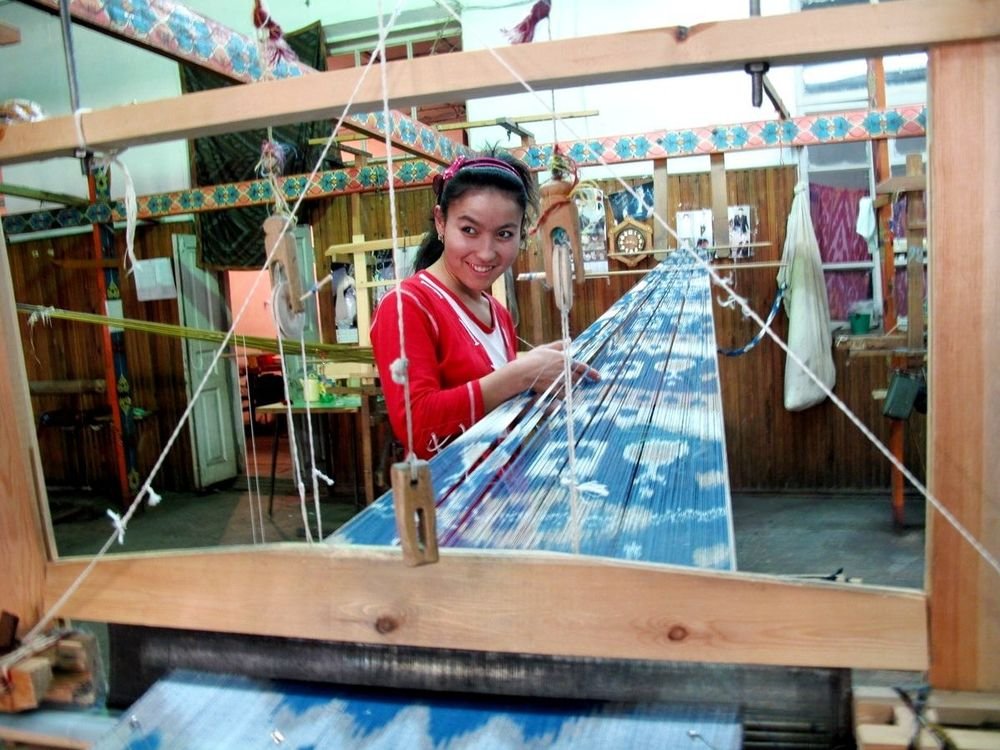Ikat – fabric conquered the world!
Bright, sunny fabric with patterns on it … As bold as our generous sun! The same kind and positive, as our friendly people!
Ikat is not a type of pattern, not a combination of colors, it is a unique technique of making fabrics, which consists of the procedure when threads are first painted and then got into a loom. The threads are tightly bunched, then all dipped in a dye. In places of a coupler fabric remains white. If it is necessary to dye the fabric in several colors, the fabric is again tensioned onto the frame; a new tie is applied, and painted a second time.

The threads are painted and dried from one to three times. Primary colors of dyes – yellow, red and blue. Before each stage of the coloring process, the master must tie up each strand in order to protect areas that are not supposed to absorb this dye. Therefore, the area that will be blue, should be tied up before painting in yellow and red; the area that will be green must absorb the yellow dye, then it must be tied up for red and then untied for blue so that the yellow and blue colors together give green. Then the threads are manually transferred to the loom, and then you can already see the outlines of the resulting pattern. In the process of weaving, the warp threads are so close to each other that they completely cover the ducks, not allowing empty spaces to disturb the purity of the design. The result is an easily recognizable ikat – a fabric with a vague, slightly rattling bright pattern.

It has always been a luxurious fabric for special occasions. Everyone wanted to have it, but not everyone could afford it: for this it was necessary to have great wealth. Depending on the income of a person in his wardrobe, there could be only one of such product – or dozens.

Not one of a patch of old ikat was thrown away. A well-worn robe for an adult could be altered for a child or be edged for other clothes.

Silk ikat was once literally worth its weight in gold – with the help of fabrics they made peace between countries, exchanged prisoners for silk, and sent it with embassies to the rulers of distant countries. Once presented to the Romanov family as ceremonial offerings by the last Bukhara emirs, silk and velvet ikats (520 samples), formed the basis of the largest textile collection not only in Russia, but also in the world.

Today, not only collectors of oriental rarities but also world-class couturiers and interior designers hunt for fabrics made in the Ikat technique. Ethnic patterns today at the height of fashion. The USA, Milan, Paris, and Rome applaud the eastern fabrics and actively use ikat in creating their masterpieces. They are: bright luxury handmade silks, colors of which resembles precious stones. Nowhere else in the world will you see this!
Khan silk
To residents of the former Soviet Union ikat is better known under the name “khan-atlas”. Historically, the largest fabric production of khan-atlas was located in Margilan. The legend connects the origin of the patterns on the “Khan silk” with the history of the artist, who saw the reflection of the rainbow in the water. The artist really did not want to give his daughter to the old ruler Margilan. On this occasion, he poured tears at the stream, and in a water ripple saw a picture of wondrous beauty. And as a result, the daughter nevertheless married – but not for the khan himself, but for his young son.
With the growing interest in Eastern philosophy and culture, the popularity of Eastern fabrics also increased. Leading designers have included models from ikat or imitations to him in their collections. For expensive products, real silk is used, for more affordable – fabrics with a similar print. The patterns typical of ikat have appeared on interior textiles in recent years – upholstery, carpets, curtains, pillowcases and bedspreads.

Signs that “wild silk” is genuine, are the presence of a slope (white band, which equals the pattern) and some blurring of the contours of the picture. Blurred outlines, as a rule, are also present in modern, stylized fabric, because without them ikat is not ikat. However, furniture is often used textiles made in modern industries, but for more or less traditional technology. Because traditional silk is not very suitable for sofa upholstery, which should serve for many years.

Ikat is appropriate in the living room, and especially in the bedroom, where it introduces the mystery of “a thousand and one nights.” Most often, this bright pattern is present in the interior in the form of small details. An ikat upholstered sofa or chair will look very impressive if you surround them with monochrome things of calm colors. To ikat can be used in large quantities, designers minimize it. For example, they leave only two colors – white and blue or shades of gray, and the drawing itself is close to a rhombus.

